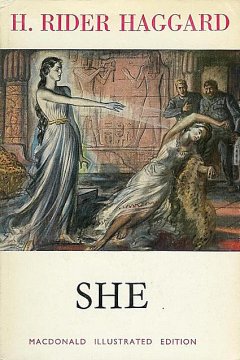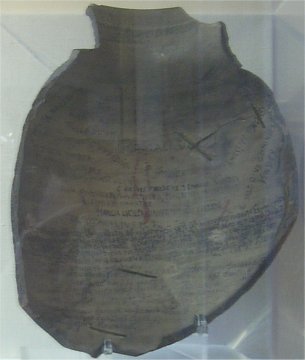
First and Only Weekly Online Fanzine Devoted to the Life & Works of Edgar Rice Burroughs
Since 1996 ~ Over 10,000 Web Pages in Archive
presents
Volume 2891

A Contribution To The ERBzine Library Project From eighteen eighty-five to two thousand nine is one hundred twenty-five years. The span records many changes. In 1885 there were no movies, no radio or TV. Movies came in c.1900 beginning to change the literary paradigm. The movies produced a definite class structure in literature. With the introduction of sound in 1927-28 two classes of film developed. A movies and B movies. A movies employed A or literary fiction such as War And Peace, Oliver Twist and such, while the developing fields of genre fiction were reduced to an inferior B status.
SHE
by
H. Rider Haggard
A Review by R.E. Prindle
Part I: The Framing DeviceTime has erased the meaning of the terms A and B pictures. I suppose that if a younger person was told that he was watching a B movie he wouldn’t know what was meant. Even if a devoted movie buff, the mere classification would have no experiential significance. You had to have been there.
In the development of the film industry it was thought that studios had to have their own theatre chains. Thus MGM movies would be shown only at Loewe’s first run theatres and so on.
In those glory days of the movies first run theatres were gorgeous temples, often named The Temple, the Roxy in NYC has the most spectacular reputation. The goal of the studios was to produce 52 A movies a year to supply the 'exhibition' chain a new first run A film a week. Only MGM was to reach this goal.
Once having been exhibited for its week or period A movies were released to rerun theatres, usually outside the chains where they were shown at reduced prices. As an added incentive a second feature was shown and this was a B movie.
We lucky kids who inhabited Saturday matinees every week year around usually got two B movies and selected short subjects which included previews, a serial, a cartoon, a newsreel, and some sort of film, usually a travelogue on deep sea fishing or water skiing matter. These comprised an alternate reality in addition to real life and dreams. Nor did we feel shorted by B movies. To our young minds these movies were fraught with the most profound thoughts imaginable. Hopalong Cassidy and Tarzan were the favorites of most kids -- Gene Autry, Roy Rogers a distant second to Gene. Unbeknownst to us of course, the literary granddaddy of the B movie was H. Rider Haggard and She.
Not that Haggard movies were shown with any regularity but he managed to anticipate all the elements of B movies to perfection. Many if not most of the key elements of B moviedom were pinched from Haggard. What Haggard didn't provide was tossed in by his disciple Edgar Rice Burroughs.
Burroughs borrowed his use of the framing device from Haggard, probably with the frame of She as his model. The framing device of Tarzan Of The Apes shows emulation of that of She. It's a good one.
Most writers of these tall yarns wanted the reader to believe he was reading a true story, in other words, an invitation to suspend disbelief- that is, everything fits in so he devised a framing story as persuasion.
The first paragraph of She's preface is perfection of its kind:
In giving to the world the record of what, considered as an adventure only, is I suppose one of the most wonderful and mysterious experiences ever undergone by mortal man, I feel it incumbent on me to explain my exact connection with it. So I will say at once that I am not the narrator but only the editor of this extraordinary history, and then go on to tell how it found its way into my hands.If one compares that to the first paragraph of Tarzan Of The Apes the similarities become immediately apparent. Both authors claim no authorship. In both cases the story, or history, was given to them by a second party. Thus Haggard the author as editor can speak in the first person while making editorial comments.The hint is made that Allan Quatermain is the actual editor. The editor was visiting Cambridge University one day some twenty years previously when he noticed two interesting people. His friend knowing them offered to introduce him.
"All right," answered my friend, "nothing easier. I know Vincey; I'll introduce you," and he did, and for some minutes we stood chatting -- about the Zulu people, I think I had just returned from the Cape at that time.So the canny reader, hopefully having read King Solomon's Mines, can infer that the unnamed editor is, in fact, Allan Quatermain as a garrulous amiable gentleman.Twenty some odd years after that casual and very brief meeting, as improbable as it may seem, one of the two men, Vincey’s guardian, Horace Holly sends the Editor the text for She.
Holly says: "You will be surprised considering the slight nature of our acquaintance to get a letter from me." I should say so. What a great memory.
Holly goes on:
I have recently read with much interest a book of yours describing a Central African adventure. I take it this book is partly true, and partly an effort of the imagination. However this may be, it has given me an idea. It happens, how you will see in the accompanying manuscript (which together with the scarab, the ‘Royal Son of the Sun), and the original sherd, I am sending you by hand) that my ward, or rather my adopted son Leo Vincey, and myself have recently passed through a real African adventure, of a nature and much more marvellous than the one which you describe, that to tell the truth I am almost ashamed to submit it to you but you should believe my tale.So Holly sees through Quatermain's preposterous story as only half true, while Holly's equally preposterous story is the whole truth, the real thing. Well, if you've accepted the premiss there's no way to go but further in so, all one can say to Holly is that his story is going to have to go some to exceed Quatermain's.Generously Holly offers any profits from publication as a reward while underwriting any possible loss. That was real Haggard accepting that bundle on Quatermain’s part.
Rounding out the baloney the editor says:
Of the history itself the reader must judge. I give it to him, with the exception of a very few alterations, made with the object of concealing the identity of the actors from the general public, exactly as it has come to me.As a reader, my judgment is that it is an excellent whopper, but I don’t believe a word -- or do I?The frame continues:
With slight [five pages] preface, which circumstances make necessary, I introduce the world to Ayesha and the Caves of Kor.Ready when you are, C.B.An excellent, convincing framing device. The Editor must be Allan Quatermain yet the name of the editor is concealed from us as well as the identities of the actors. Where we are going is mystery piled on mystery, the strange and wonderful lie before us, we in complete safety.
So with Burroughs' framing device of Tarzan Of The Apes. While not copied word for word, certainly idea for idea. The influence of Haggard is apparent, but not paramount. Burroughs' mind was a maelstrom into which innumerable influences (a slight exaggeration) are drawn to the depths of his subconscious and emerge melded into something so close and yet so different than his many, many sources.
Having roped the reader in like a carnival barker luring the victim into his peep show Haggard begins to lay out his nearly perfect story of the type.
Part B follows.


Listen
to the radio adaptation
from
the 1948 Escape broadcast
|
|
|
|
|
|
|
|
|
|
R. E. Prindle welcomes your comments
at:
dugwarbaby@yahoo.com
|
and Follow the Navigation Chart for the Entire Series of Articles |
|
Differing viewpoints are welcome. |
|
are not necessarily those held by Edgar Rice Burroughs, Inc. |
![]()

![]()
From

tarzana.ca
The
Fantastic Worlds of Edgar Rice Burroughs
![]()

![]()
BILL
HILLMAN
Visit
our thousands of other sites at:
BILL
and SUE-ON HILLMAN ECLECTIC STUDIO
ERB
Text, ERB Images and Tarzan® are ©Edgar Rice Burroughs, Inc.-
All Rights Reserved.
All
Original Work ©1996-2009/2012 by Bill Hillman and/or Contributing
Authors/Owners
No
part of this web site may be reproduced without permission from the respective
owners.